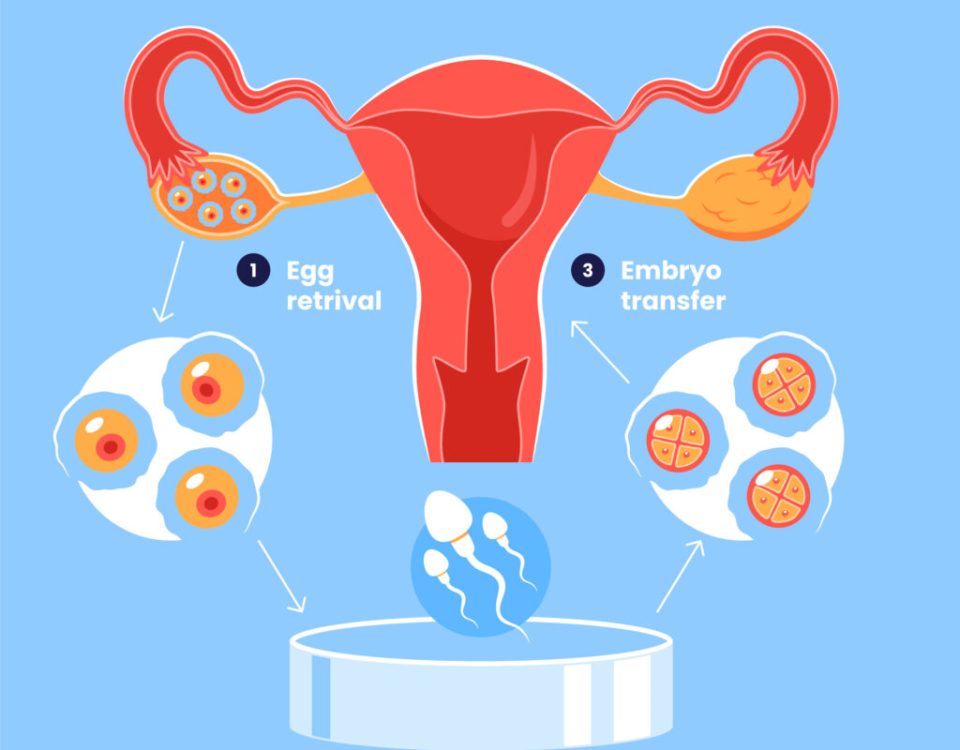Does Aetna Cover IVF? Your Guide to Understanding Fertility Benefits
April 19, 2025
Does a Doctor Perform Egg Retrieval for IVF in Georgia?
April 19, 2025Does Blue Cross Blue Shield Cover IVF?
When you’re dreaming of starting a family, the journey can feel overwhelming—especially if fertility treatments like in vitro fertilization (IVF) are part of the picture. IVF is a game-changer for many, but it’s no secret that it comes with a hefty price tag. If you’re insured with Blue Cross Blue Shield (BCBS), you might be wondering: Does my plan cover IVF? The answer isn’t a simple yes or no—it depends on your specific plan, where you live, and even your employer. Let’s dive into everything you need to know about BCBS and IVF coverage, from the basics to the nitty-gritty details that could save you time, money, and stress.
What Is IVF, and Why Does Coverage Matter?
IVF is a fertility treatment where eggs are retrieved from the ovaries, fertilized with sperm in a lab, and then transferred into the uterus. It’s often a lifeline for people facing infertility due to blocked fallopian tubes, low sperm count, or unexplained challenges. But here’s the catch: a single IVF cycle can cost between $12,000 and $20,000, not including medications, which can add another $3,000 to $5,000. For many, that’s a huge financial hurdle.
Insurance coverage can make or break the decision to pursue IVF. With BCBS being one of the largest insurance providers in the U.S., covering millions through individual, employer-sponsored, and federal plans, understanding what they offer is key. If BCBS covers IVF for you, it could turn a distant dream into a real possibility.
The Big Picture: Does BCBS Cover IVF?
Blue Cross Blue Shield isn’t a single company—it’s a network of 34 independent companies operating across every state. This means coverage varies widely depending on your location and plan. Some BCBS plans offer robust IVF benefits, while others might not cover it at all. Here’s what you need to know upfront:
- State Laws Play a Role: In states with infertility insurance mandates (like Illinois, New York, or Massachusetts), BCBS plans are more likely to cover IVF. These mandates require insurers to include fertility treatments, though specifics differ.
- Plan Type Matters: Employer-sponsored plans, individual marketplace plans, and federal employee plans (like the Federal Employees Health Benefits Program, or FEHB) each have unique rules.
- It’s Not Guaranteed: Even if your state mandates coverage, exclusions might apply—like if your employer self-insures and opts out of state rules.
So, the first step is figuring out which BCBS company insures you and what your plan says about fertility treatments. Don’t worry—we’ll walk you through how to do that.
How to Check Your BCBS IVF Coverage
Unsure where to start? You don’t need to be a detective to get answers. Here’s a simple guide to find out if your BCBS plan covers IVF:
- Grab Your Insurance Card: Look for the customer service number on the back. This connects you to your specific BCBS provider (e.g., BCBS of Texas, BCBS of Michigan).
- Log Into Your Account: Most BCBS companies have online portals where you can download your plan’s “Summary of Benefits and Coverage” (SBC). Search for terms like “infertility,” “IVF,” or “assisted reproductive technology” (ART).
- Call and Ask: Speak to a representative and ask directly: “Does my plan cover IVF, and what are the limits or requirements?” Have your policy number ready—they’ll need it.
- Check with HR: If you’re on an employer plan, your human resources team might have details about fertility benefits.
Pro tip: Record the date, time, and name of the person you speak with. Insurance can be tricky, and having a paper trail helps if you need to appeal a denial later.
What You Might Find
When you dig into your plan, you could see a range of outcomes:
- ✔️ Full Coverage: Some plans cover multiple IVF cycles, including meds and lab fees, up to a dollar limit (e.g., $25,000 annually).
- ✔️ Partial Coverage: Others might cover diagnostics (like blood tests) and medications but not the IVF procedure itself.
- ❌ No Coverage: If your plan excludes IVF, you’re on the hook for the full cost unless you qualify for special programs.
State Mandates: A Game-Changer for IVF Coverage
Where you live can tip the scales. As of April 2025, 21 states plus Washington, D.C., have laws requiring some level of infertility coverage. These mandates don’t guarantee IVF is included, but they increase the odds. Here’s a quick look at how this works with BCBS:
| State | Mandate Details | Likely BCBS Coverage |
|---|---|---|
| Illinois | Covers up to 4 egg retrievals and IVF | High chance of IVF inclusion |
| New York | Covers 3 IVF cycles for large group plans | Good odds, but check specifics |
| Texas | Must offer infertility coverage, but optional | Spotty—depends on your plan |
| California | No IVF mandate, but diagnostics often covered | Less likely unless employer adds it |
If you’re in a mandate state, BCBS plans sold on the individual market or through small employers usually follow these rules. But big companies that self-insure (common with national chains) can sidestep state laws under federal regulations. That’s why two people with BCBS in the same state might have totally different experiences.
Real-Life Example
Take Sarah, a 32-year-old teacher in Chicago. Her BCBS of Illinois plan, thanks to the state’s strong mandate, covered three IVF cycles after a $500 deductible. She paid about $2,000 out of pocket for meds and extras—way less than the $15,000+ she’d have faced without coverage. Meanwhile, her cousin in Florida, also with BCBS, got zero IVF help because Florida has no mandate, and her employer didn’t opt in.
Federal Employees and BCBS: A Bright Spot
If you’re a federal employee under the FEHB program, you’ve got some of the best odds for IVF coverage with BCBS. In 2025, the Blue Cross Blue Shield Federal Employee Program (FEP) stepped up its game. Here’s the scoop:
- Standard Option: Covers up to $25,000 annually for assisted reproductive technology (ART), including IVF, with prior approval.
- Basic Option: Includes three IVF drug cycles per year, but not the full procedure.
- New in 2025: More mental health support and egg/sperm storage for those facing medical treatments (like chemo) that cause infertility.
This is huge—especially since one in five women struggle with infertility, according to the CDC. Federal workers now have a solid safety net, but you still need to meet eligibility rules, like a medical diagnosis of infertility (e.g., trying for 12 months without success if under 35, or 6 months if over 35).
Interactive Quiz: Are You Eligible?
Wondering if you’d qualify for FEP’s IVF benefits? Take this quick quiz:
- Are you enrolled in BCBS FEP Standard Option?
- Yes (1 point) / No (0 points)
- Have you been trying to conceive for at least 12 months (or 6 if over 35)?
- Yes (1 point) / No (0 points)
- Do you have a doctor’s diagnosis of infertility?
- Yes (1 point) / No (0 points)
Score:
- 3 points: You’re likely eligible—call FEP to confirm!
- 1-2 points: You might qualify with more documentation.
- 0 points: Coverage could be a long shot.
What’s Typically Covered (and What’s Not)?
Even when BCBS covers IVF, it’s not a blank check. Plans often break it down into pieces. Here’s what you might see:
Covered:
- ✔️ Diagnostics: Blood tests, ultrasounds, and semen analysis to pinpoint infertility causes.
- ✔️ Medications: Drugs like Clomid or injectables (e.g., Gonal-F) to boost egg production.
- ✔️ IVF Procedure: Egg retrieval, fertilization, and embryo transfer—sometimes with a cycle limit (e.g., 3 per year).
- ✔️ Storage: Some plans cover freezing eggs or embryos, especially for medical reasons.
Not Covered:
- ❌ Experimental Treatments: Things like preimplantation genetic testing (PGT) might be excluded unless medically necessary.
- ❌ Surrogacy: Most plans won’t touch costs if you’re using a surrogate.
- ❌ Out-of-Network Providers: Stick to in-network clinics, or you could pay full price.
A Hidden Gem: Iatrogenic Infertility
One lesser-known perk? If infertility stems from a medical treatment—like cancer therapy—some BCBS plans (especially FEP) cover egg or sperm storage for a year. This isn’t widely advertised, so ask about “iatrogenic infertility” benefits if it applies to you.
The Cost Breakdown: With and Without Coverage
Let’s put numbers to it. Here’s how costs stack up based on real-world data:
| Expense | No Coverage | With BCBS Coverage (Example) |
|---|---|---|
| IVF Cycle | $12,000 | $0-$2,000 (after deductible) |
| Medications | $5,000 | $300-$1,000 (co-pay or coinsurance) |
| Diagnostic Tests | $1,500 | $0-$200 (in-network) |
| Total per Cycle | $18,500 | $300-$3,200 |
With coverage, you could save over 80%—a massive relief. But if IVF isn’t covered, don’t lose hope. We’ll explore workarounds later.
Three Under-the-Radar Factors That Affect Coverage
Most articles skim the surface, but these lesser-discussed details can make or break your IVF journey with BCBS:
1. Preauthorization Is a Must
Many BCBS plans require preapproval before you start IVF. Skip this step, and you could be denied coverage even if it’s technically included. Call your insurer before your first appointment and ask what paperwork your doctor needs to submit. A 2023 study from the American Society for Reproductive Medicine found 1 in 4 claims get denied due to missing preauthorization—don’t let that be you.
2. Age Limits Sneak In
Some plans cap IVF coverage at age 40 or 45, based on success rates dropping as you get older. For example, BCBS of Massachusetts might cover you fully at 35 but not at 42. Check your policy’s fine print—age restrictions aren’t always obvious.
3. Your Partner’s Coverage Counts
If you and your partner have separate BCBS plans, compare them. One might cover IVF while the other doesn’t. A couple in Virginia saved $10,000 by switching to the husband’s FEP plan, which included IVF, instead of the wife’s bare-bones individual plan. Coordinate with your partner to maximize benefits.
What If BCBS Doesn’t Cover IVF?
No coverage? You’re not out of options. Here are practical ways to make IVF work:
Option 1: Appeal the Denial
Insurance companies sometimes say no at first but reverse it if you push back. Gather medical records, a doctor’s letter explaining why IVF is necessary, and proof of infertility (like test results). A 2024 Resolve survey found 30% of appeals succeed with proper documentation.
Option 2: Employer Advocacy
If you’re on a work plan, talk to HR. Companies like Starbucks and Amazon have added IVF benefits due to employee demand. Suggest BCBS’s “Blue Distinction Centers for Fertility Care”—a network of top clinics—as a selling point. Your boss might not realize how common this perk is becoming.
Option 3: Financing and Grants
- Clinics: Many offer payment plans or discounts for self-pay patients.
- Loans: Companies like Prosper Healthcare Lending provide IVF-specific financing with low monthly payments.
- Grants: Nonprofits like Baby Quest Foundation award up to $15,000 for treatment costs. Apply early—funds run out fast.
Real Story: Making It Work
Meet Jen, a 38-year-old from North Carolina. Her BCBS plan didn’t cover IVF, so she applied for a grant, negotiated a $2,000 discount with her clinic, and used a tax-free HSA to cover meds. After one cycle, she welcomed twins—proof you can get creative and win.
Latest Trends: What’s Changing in 2025?
IVF coverage is evolving fast. Here’s what’s hot as of April 2025:
- Federal Push: The Biden administration expanded FEHB IVF benefits, setting a precedent. Private BCBS plans might follow suit to stay competitive.
- Mental Health Tie-In: More plans, like BCBS FEP, now pair IVF coverage with counseling. A 2024 study in Fertility and Sterility found 40% of IVF patients experience anxiety—support matters.
- Employer Perks: Job sites like Glassdoor show a spike in companies advertising IVF benefits to attract talent. Check job listings—your next gig could fund your family.
Poll: What’s Your Priority?
If BCBS offered IVF coverage, what would matter most to you?
- A) Full procedure coverage
- B) Affordable meds
- C) Freezing options
- D) Mental health support
Drop your vote in the comments—we’re curious!
Unique Insights: Beyond the Basics
Most articles stop at “check your plan,” but let’s go deeper with three points you won’t find elsewhere:
1. The Rural Coverage Gap
Living in a small town? BCBS might cover IVF, but in-network clinics could be hours away. A 2023 analysis by the Rural Health Research Center found 1 in 3 rural women lack local fertility care. Call BCBS to see if they’ll waive out-of-network penalties or reimburse travel costs—some plans do this quietly.
2. Secondary Infertility Surprise
Already have a kid but struggling with the next? Some BCBS plans exclude “secondary infertility” from IVF benefits, assuming one child is enough. If this hits you, appeal with data—studies show secondary infertility affects 10% of couples, per the National Institutes of Health.
3. Tax Breaks You’re Missing
IVF expenses, even without coverage, can be tax-deductible as medical costs if they exceed 7.5% of your adjusted gross income. A quick calculation: if you earn $60,000 and spend $18,000 on IVF, you could deduct $13,500. Talk to a tax pro—it’s a hidden lifeline.
Your Action Plan: Next Steps
Ready to tackle IVF with BCBS? Here’s your roadmap:
- Confirm Coverage: Call BCBS today and get specifics in writing.
- Find a Clinic: Use BCBS’s provider search for in-network fertility specialists.
- Prep Documents: Gather infertility proof and preauthorization forms.
- Explore Backup Plans: Research grants or financing if coverage falls short.
- Talk to Your Doctor: Ask about affordable med options or multi-cycle discounts.
Checklist: Are You Ready?
- ✔️ Reviewed my plan’s infertility section
- ✔️ Called BCBS for clarification
- ✔️ Found an in-network clinic
- ❌ Still need to check state laws
- ❌ Haven’t explored grants yet
Tick off what you’ve done and tackle the rest—every step gets you closer.
Final Thoughts: Hope Is on Your Side
Navigating IVF with Blue Cross Blue Shield can feel like a maze, but you’ve got this. Whether your plan covers every step or leaves you piecing it together, there’s a path forward. Millions have built families through IVF, and with the right info, you can too. Start with a phone call, lean on your support system, and don’t be afraid to ask for help—your future family is worth it.
Have a BCBS IVF story or tip? Share it below—let’s help each other out!




